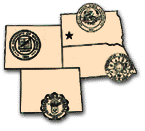Animal Science, Department of

Range Beef Cow Symposium
Date of this Version
2013
Document Type
Article
Citation
Range Beef Cow Symposium XXIII, December 3-5, 2013, Rushmore Plaza Civic Center, Rapid City, SD.
Abstract
Drought is a common occurrence for South Dakota beef producers. The variation in weed control that ranchers need to manage for is the intensity and duration of the rainfall shortages. The common problem however, is what happens when grass and forbs become stressed and the changes to the vegetation that occurs. Stresses or disturbances that cause the grasses to slow growth and open up bare areas can include several situations; over grazing, flooding, wild fires, severe hail, growing season freeze, soil disturbances (prairie dogs or pocket gophers), and drought. Weeds are very opportunistic and competitive and will readily invade bare areas of ground that are created by these conditions. Once established weeds will aggressively compete for light, nutrients, moisture and space. This will allow for quick weed establishment and when more favorable conditions occur, weeds will spread to new areas and weed densities will increase. Weeds can be divided into three growth categories; 1. Annuals, 2. Biennials, and 3. Perennials. Within these groups they can further be categorized as cool season or warm season plants or as a broadleaf, grass or sedge plants. The plants we tend to be more concerned with during or following drought are the broadleaf weeds. The broadleaf weeds that cause the biggest problems are those introduced or invasive plants that have gotten a foothold here. In South Dakota the invasive weeds of major emphasis for grasslands include Canada thistle, leafy spurge, hoary cress, the knapweeds, biennial thistles (musk, plumeless, bull and scotch), the toadflaxes, field bindweed, absinth wormwood and common mullein. All of these and others are on South Dakota’s state wide and locally noxious lists. They are considered regulated pests in the state. Another group of plants that can take advantage of drought and become a problem in range settings is some native forbs like the vervains, common sunflower, horseweed or marestail, golden rod family, perennial ragweed and cudweed sagewort. In normal conditions these plants are not considered invasive. They can have good forage value at certain growth stages. This can reduce grazing pressure on desirable grass species recovering form drought.


Comments
Copyright © 2013 Darrell L. Deneke.